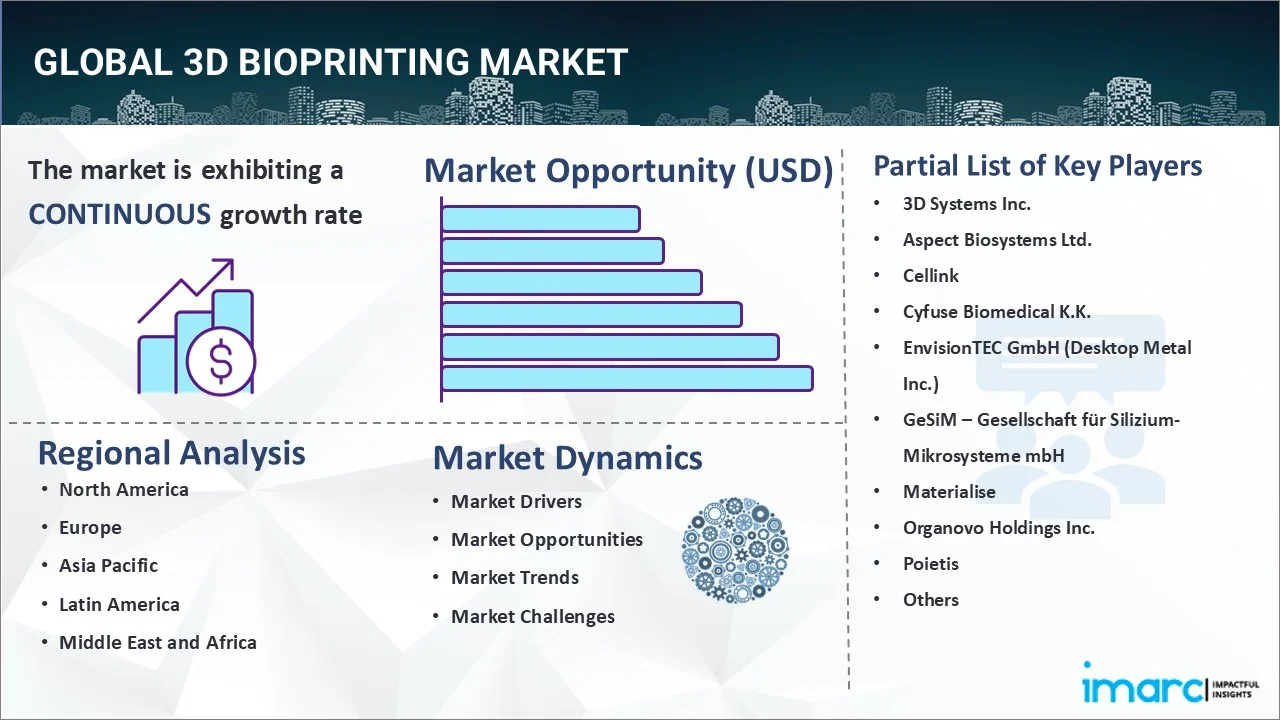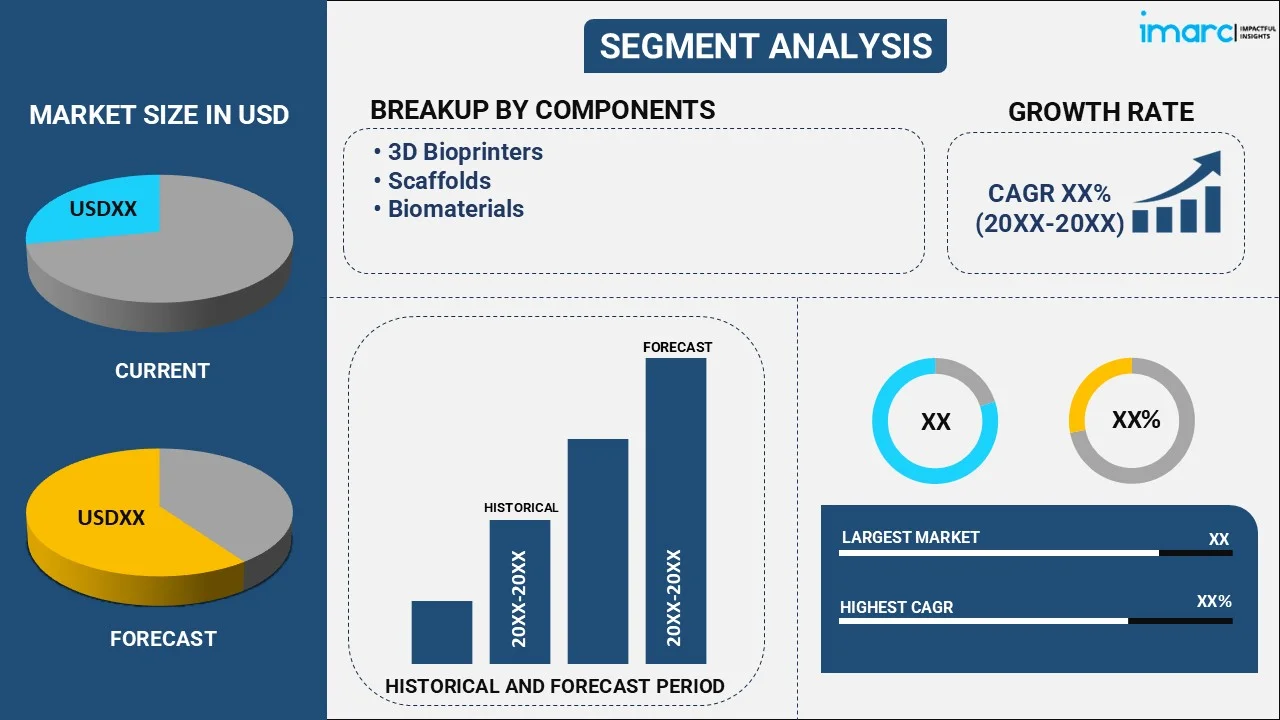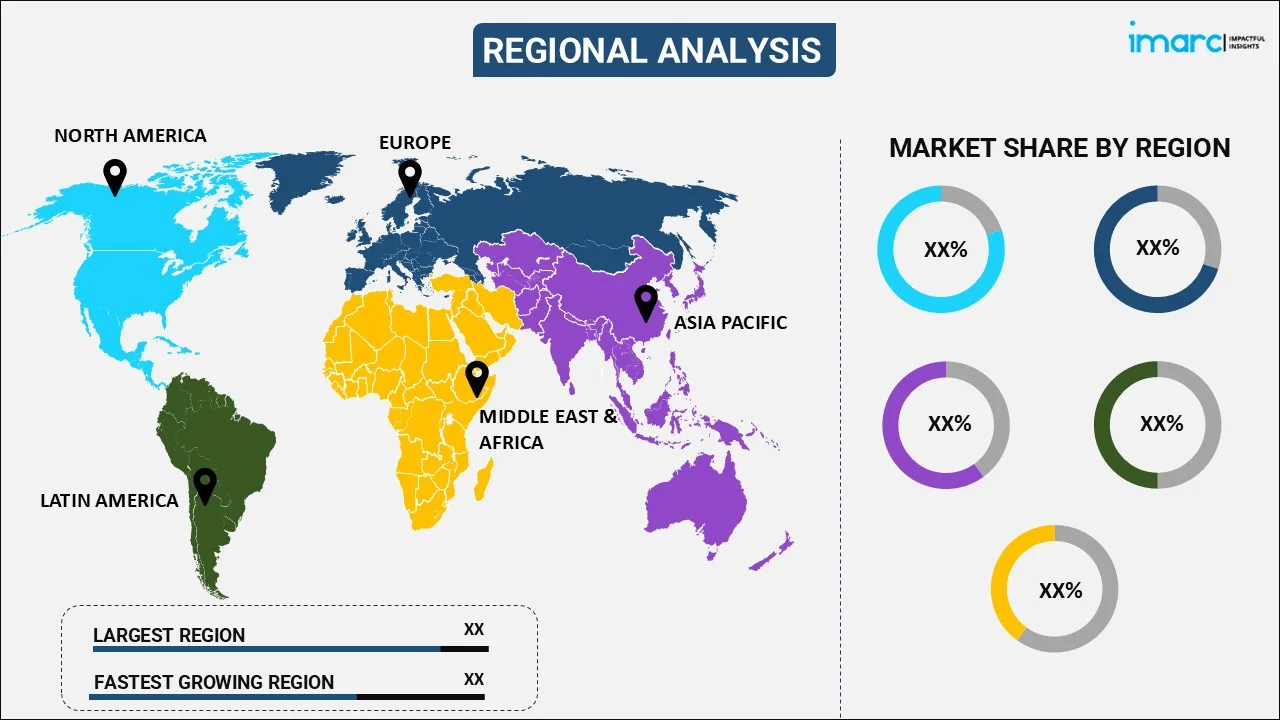
3D Bioprinting Market Report by Component (3D Bioprinters, Scaffolds, Biomaterials), Application (Research, Clinical), End User (Hospitals, Research Organization and Academic Institutes, Biopharmaceuticals Companies), and Region 2025-2033
Global 3D Bioprinting Market:
The global 3D bioprinting market size reached USD 1,382.7 Million in 2024. Looking forward, IMARC Group expects the market to reach USD 4,738.5 Million by 2033, exhibiting a growth rate (CAGR) of 13.93% during 2025-2033. The growing geriatric population, increasing focus on research and development (R&D) activities, and less disrupted market represent some of the key factors driving the market growth.
|
Report Attribute
|
Key Statistics
|
|---|---|
|
Base Year
|
2024
|
|
Forecast Years
|
2025-2033
|
|
Historical Years
|
2019-2024
|
|
Market Size in 2024
|
USD 1,382.7 Million |
|
Market Forecast in 2033
|
USD 4,738.5 Million |
| Market Growth Rate 2025-2033 | 13.93% |
3D Bioprinting Market Analysis:
- Major Market Drivers: The increasing utilization of 3D bioprinting in personalized medicine is primarily driving the growth of the market. 3D bioprinting can create patient-specific tissues and organs, enabling personalized treatment plans and reducing the risk of transplant rejection.
- Key Market Trends: The escalating utilization of bioprinting to manufacture complex biomedical devices and implants with precise geometries and biological functionalities is one of the significant trends driving the growth of the market. Furthermore, rapid advancements in 3D bioprinting technology, including improved biomaterials and printing techniques, are also contributing to the market expansion.
- Competitive Landscape: Some of the leading players operating in the global market include 3D Systems Inc., Aspect Biosystems Ltd., Cellink, Cyfuse Biomedical K.K., EnvisionTEC GmbH (Desktop Metal Inc.), GeSiM – Gesellschaft für Silizium-Mikrosysteme mbH, Materialise, Organovo Holdings Inc., Poietis, RegenHU, and Stratasys Ltd., among others.
- Geographical Landscape: According to the report, North America (the United States and Canada) was the largest market for 3D bioprinting. Some of the factors driving the North American 3D bioprinting market include the growing prevalence of various chronic diseases, the wide presence of key players, and increasing private and government investment.
- Challenges and Opportunities: The global 3D bioprinting market faces challenges such as high costs, technical complexities, and regulatory hurdles. However, it presents opportunities to advance personalized medicine, improve drug testing accuracy, and address organ transplant shortages through innovative tissue engineering solutions.

3D Bioprinting Market Trends:
Increasing Drug Testing and Development
3D bioprinters are highly important for drug testing and clinical trial applications. They are expected to drastically reduce the need for animal trials, thus being ethically beneficial and cost-effective. With the advent of 3D bioprinting, drug developers can easily identify complications associated with human clinical trials by testing new drugs on human-like 3D-printed tissues, thereby reducing losses from late-stage failures. Additionally, the increasing investment in research and development by the companies is further escalating the demand for innovative technologies like 3D bioprinting. For instance, according to the data published by the Congressional Budget Office, in 2021, it has been observed that pharmaceutical industries spent nearly US$ 200 Billion on research and development in 2020 globally compared to US$ 83 Million in 2019. Similarly, Danaher Corporation invested US$ 1,742 Million in its research and development in 2021, as compared to US$ 1,348 Million in 2020. In addition, Bio-Rad Laboratories Inc. invested US$ 879.6 Million in 2021 as compared to US$ 800.3 Million in 2020. Such significant investments in drug trials and drug development are anticipated to propel the 3D bioprinting market size in the coming years.
Technological Advancements
Ongoing technological advancements in 3D bioprinting are further offering lucrative growth opportunities to the overall market. Additionally, various leading market players are collaborating and forming partnerships to develop more advanced and efficient 3D bioprinting technologies. For instance, in June 2024, advanced tissue mimetic technologies company Ronawk partnered with B9Creations to develop and mass-produce 3D bioprinted hydrogels leveraging Ronawk's Bio-Blocks. Unlike traditional methods that force cells into artificial environments, Ronawk's Bio-Blocks recreate conditions that allow cells to form tissues naturally. This results in tissue that closely resembles the native architecture and function of human and animal tissues. Similarly, in September 2022, the Indian Institute of Science (IISc) announced its collaboration with CELLINK, a Sweden-based bioprinting solutions company, to provide two to three bioprinters to the Centre of Excellence (CoE), each of which uses a different printing technology at its own cost. Additionally, in December 2022, CELLINK and IISc jointly established Bengaluru's pioneering 3D Bioprinting Centre of Excellence in India. Such innovations, collaborations, and expansion in 3D bioprinting are projected to positively impact the 3D bioprinting market outlook over the forecasted period.
Growing Product Application in Cancer Research
3D bioprinting is widely used in the creation of realistic tumor models that closely mimic the complexity and microenvironment of actual human tumors. These bioprinted models enable researchers to study cancer progression, metastasis, and tumor-stroma interactions in a controlled setting. Moreover, the escalating cases of cancer across the globe are further offering lucrative growth opportunities to the overall market. For instance, the International Agency for Research on Cancer (IARC) estimated that, in the year 2020, there were about 19.29 million cancer cases. These cases are projected to increase to 24.58 million cases by 2030. Additionally, according to GLOBOCAN, in 2020, there were approximately 2,281,658 new cancer cases diagnosed and 612,390 deaths due to cancer alone in the United States. In addition to this, lung cancer and breast cancer are two of the most common cancers found among individuals. The Canadian Cancer Society (CCS) stated that in 2020, nearly 29,800 Canadians were diagnosed with lung cancer, which accounted for 13% of all new cancer cases. About 21,200 Canadians were expected to die from lung cancer, which represented 25% of all cancer deaths in 2020. Such a substantial growth in cancer cases is augmenting the demand for 3D bioprinting technologies that help identify effective treatments, understand drug resistance mechanisms, and personalize cancer therapies.
Global 3D Bioprinting Industry Segmentation:
IMARC Group provides an analysis of the key trends in each segment of the global 3D bioprinting market report, along with forecasts at the global, regional, and country levels from 2025-2033. Our report has categorized the market based on component, application, and end user.
Component Insights:

- 3D Bioprinters
- Syringe/Extrusion Bioprinting
- Inkjet Bioprinting
- Magnetic Levitation Bioprinting
- Laser-assisted Bioprinting
- Others
- Scaffolds
- Biomaterials
- Living Cells
- Hydrogels
- Extracellular Matrices
- Others
3D bioprinters (syringe/extrusion bioprinting, inkjet bioprinting, magnetic levitation bioprinting, laser-assisted bioprinting, and others) represented the largest segment
The 3D bioprinting market research report has provided a detailed breakup and analysis of the 3D bioprinting market based on the component. This includes 3D bioprinters (syringe/extrusion bioprinting, inkjet bioprinting, magnetic levitation bioprinting, laser-assisted bioprinting, and others), scaffolds, and biomaterials (living cells, hydrogels, extracellular matrices, and others). According to the report, 3D bioprinters (syringe or extrusion bioprinting, inkjet bioprinting, magnetic levitation bioprinting, laser-assisted bioprinting, and others) represented the largest segment.
The bolstering demand for 3D bioprinters can be attributed to the increasing utilization of syringe or extrusion-based bioprinting technology in printing various biological compounds or devices. They are widely used in fabricating tissue scaffolds for regenerative medicine, developing organ models for transplant research, and creating realistic tissue models for drug testing and cancer research. Moreover, 3D bioprinters have the ability to produce complex, customized biological structures, improve the accuracy of drug testing, and reduce the need for animal testing. As a result, they are widely used in the fields of tissue engineering, personalized medicine, pharmaceutical development, and medical research.
Application Insights:
- Research
- Drug Research
- Regenerative Medicine
- 3D Cell Culture
- Clinical
- Skin
- Bone and Cartilage
- Blood Vessels
- Others
Research (drug research, regenerative medicine, and 3D cell culture) accounted for the largest market share
A detailed breakup and analysis of the 3D bioprinting market based on the application has also been provided in the report. This includes research (drug research, regenerative medicine, and 3D cell culture) and clinical (skin, bone and cartilage, blood vessels, and others). According to the report, research (drug research, regenerative medicine, and 3D cell culture) accounted for the largest market share.
The growth of this segment can be attributed to the widespread utilization of 3D printing technology among researchers to study the effects of different diseases and their progression and possible treatments. Moreover, it reduces the need to use lab animals for medical tests and dangerous trials on humans. Additionally, the 3D bioprinting market forecast by IMARC indicates that the increasing drug development and drug trial activities are bolstering the application of 3D bioprinting in research. For instance, with the COVID-19 pandemic behind, the US Food and Drug Administration (FDA) approved 55 new drugs in 2023, a figure consistent with the number authorized in the last five years (53 per year on average). Thus, 2023 marks the second-best yearly FDA harvest after 2018 (59 approvals) in all the series. Such a significant growth in drug trials and approval is creating a positive outlook for the overall market.
End User Insights:
- Hospitals
- Research Organization and Academic Institutes
- Biopharmaceuticals Companies
Biopharmaceuticals companies accounted for the largest market share
A detailed breakup and analysis of the 3D bioprinting market based on the end user has also been provided in the report. This includes hospitals, research organization and academic institutes, and biopharmaceuticals companies. According to the report, biopharmaceuticals companies accounted for the largest market share.
The 3D bioprinting market statistics by IMARC indicate that the increasing number of target therapies is primarily driving the growth of this segment. In addition to this, the rising collaborations and mergers and acquisition activities among biopharmaceutical companies to develop 3D bioprinting are positively influencing the market. For instance, in June 2022, REGEMAT 3D, a company at the forefront of personalized bio fabrication solutions, announced a partnership with Humabiologics, a company providing human-derived biomaterials for regenerative medicine, in response to the growing demand and to serve a broader life sciences customer base of the industry partners and academic institutions in the European bioprinting and drug testing market.
Regional Insights:

- North America
- United States
- Canada
- Asia-Pacific
- China
- Japan
- India
- South Korea
- Australia
- Indonesia
- Others
- Europe
- Germany
- France
- United Kingdom
- Italy
- Spain
- Russia
- Others
- Latin America
- Brazil
- Mexico
- Others
- Middle East and Africa
North America (the United States and Canada) was the largest market for 3D bioprinting
The report has also provided a comprehensive analysis of all the major regional markets, which include North America (the United States and Canada); Asia Pacific (China, Japan, India, South Korea, Australia, Indonesia, and others); Europe (Germany, France, the United Kingdom, Italy, Spain, Russia, and others); Latin America (Brazil, Mexico, and others); and the Middle East and Africa. According to the report, North America (the United States and Canada) was the largest market for 3D bioprinting.
Some of the factors driving the North American 3D bioprinting market included the growing prevalence of various chronic diseases, the presence of key players, and increasing private and government investments. Additionally, new product launches by the key market players in the region, along with the easy allocation of funds to conduct R&D activities, are further creating a positive outlook for the overall market. For instance, in 2022, scientists from Florida Atlantic University and the University of Virginia created a robotic model of the human spine to assist surgeons in anticipating the outcomes of interventions before surgery. Thus, the increasing demand for 3D bioprinting for healthcare physicians is expected to boost the market over the forecast period. Additionally, the rising investments by the regional government authorities in the healthcare sector are projected to propel the 3D bioprinting market share in the coming years.
Competitive Landscape:
The report has also provided a comprehensive analysis of the competitive landscape in the global 3D bioprinting market. Some of the companies covered in the report include:
- 3D Systems Inc.
- Aspect Biosystems Ltd.
- Cellink
- Cyfuse Biomedical K.K.
- EnvisionTEC GmbH (Desktop Metal Inc.)
- GeSiM – Gesellschaft für Silizium-Mikrosysteme mbH
- Materialise
- Organovo Holdings Inc.
- Poietis
- RegenHU
- Stratasys Ltd.
(Please note that this only represents a partial list of companies, and the complete list has been provided in the report.)
Global 3D Bioprinting Market News:
- June 2024: Advanced tissue mimetic technologies company Ronawk partnered with B9Creations to develop and mass-produce 3D bio-printed hydrogels leveraging Ronawk’s Bio-Blocks.
- February 2024: Nanavati Max Super Specialty Hospital in Mumbai, India, launched a medical 3D printing laboratory to facilitate high-precision surgeries. The facility is closely integrated with oncology to enable state-of-the-art surgeries that need to be performed carefully and accurately in oncologic, reconstructive orthopedic, and specialized dentistry surgeries. The 3D printing laboratory features two 3D printers capable of producing bone models for a better understanding of intricate anatomy or pathology.
Global 3D Bioprinting Market Report Scope:
| Report Features | Details |
|---|---|
| Base Year of the Analysis | 2024 |
| Historical Period | 2019-2024 |
| Forecast Period | 2025-2033 |
| Units | Million USD |
| Scope of the Report | Exploration of Historical Trends and Market Outlook, Industry Catalysts and Challenges, Segment-Wise Historical and Predictive Market Assessment:
|
| Components Covered |
|
| Applications Covered |
|
| End Users Covered | Hospitals, Research Organization and Academic Institutes, Biopharmaceuticals Companies |
| Regions Covered | Asia Pacific, Europe, North America, Latin America, Middle East and Africa |
| Countries Covered | United States, Canada, Germany, France, United Kingdom, Italy, Spain, Russia, China, Japan, India, South Korea, Australia, Indonesia, Brazil, Mexico |
| Companies Covered | 3D Systems Inc., Aspect Biosystems Ltd., Cellink, Cyfuse Biomedical K.K., EnvisionTEC GmbH (Desktop Metal Inc.), GeSiM – Gesellschaft für Silizium-Mikrosysteme mbH, Materialise, Organovo Holdings Inc., Poietis, RegenHU, Stratasys Ltd, etc. |
| Customization Scope | 10% Free Customization |
| Post-Sale Analyst Support | 10-12 Weeks |
| Delivery Format | PDF and Excel through Email (We can also provide the editable version of the report in PPT/Word format on special request) |
Key Benefits for Stakeholders:
- IMARC’s industry report offers a comprehensive quantitative analysis of various market segments, historical and current market trends, market forecasts, and dynamics of the 3D bioprinting market from 2019-2033.
- The research report provides the latest information on the market drivers, challenges, and opportunities in the global 3D bioprinting market.
- The study maps the leading, as well as the fastest-growing, regional markets. It further enables stakeholders to identify the key country-level markets within each region.
- Porter's five forces analysis assists stakeholders in assessing the impact of new entrants, competitive rivalry, supplier power, buyer power, and the threat of substitution. It helps stakeholders to analyze the level of competition within the 3D bioprinting industry and its attractiveness.
- The competitive landscape allows stakeholders to understand their competitive environment and provides insight into the current positions of key players in the market.
Key Questions Answered in This Report
The global 3D bioprinting market was valued at USD 1,382.7 Million in 2024.
We expect the global 3D bioprinting market to exhibit a CAGR of 13.93% during 2025-2033.
The increasing application of 3D bioprinting for liver modeling and development of medical implants, is currently catalyzing the global 3D bioprinting market.
The sudden outbreak of the COVID-19 pandemic has led to the rising use for 3D bioprinting as a rapid fabrication method for designing and producing preventive, diagnostic, and treatment devices to combat the spread of coronavirus infection.
Based on the component, the global 3D bioprinting market can be segmented into 3D bioprinters, scaffolds, and biomaterials. Among these, 3D bioprinters, including syringe/extrusion bioprinting currently holds the majority of the total market share.
Based on the application, the global 3D bioprinting market has been divided into research and clinical. Currently, research exhibits a clear dominance in the market.
Based on the end user, the global 3D bioprinting market can be categorized into hospitals, research organization and academic institutes, and biopharmaceuticals companies. Among these, biopharmaceuticals companies currently account for the largest market share.
On a regional level, the market has been classified into North America, Asia-Pacific, Europe, Latin America, and Middle East and Africa, where North America currently dominates the global market.
Some of the major players in the global 3D bioprinting market include 3D Systems Inc., Aspect Biosystems Ltd., Cellink, Cyfuse Biomedical K.K., EnvisionTEC GmbH (Desktop Metal Inc.), GeSiM – Gesellschaft für Silizium-Mikrosysteme mbH, Materialise, Organovo Holdings Inc., Poietis, RegenHU, and Stratasys Ltd.
Need more help?
- Speak to our experienced analysts for insights on the current market scenarios.
- Include additional segments and countries to customize the report as per your requirement.
- Gain an unparalleled competitive advantage in your domain by understanding how to utilize the report and positively impacting your operations and revenue.
- For further assistance, please connect with our analysts.
 Request Customization
Request Customization
 Speak to an Analyst
Speak to an Analyst
 Request Brochure
Request Brochure
 Inquire Before Buying
Inquire Before Buying




.webp)




.webp)












